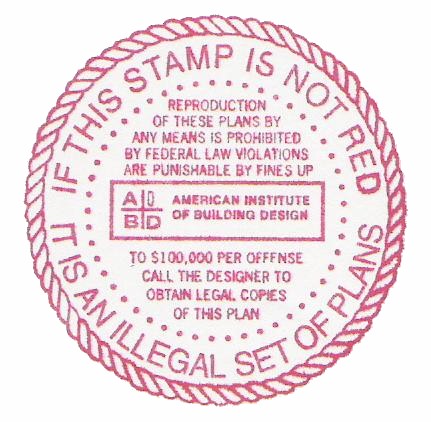|
The following
information is provided by the law firm of Coats &
Bennett, PLLC.
-
Home plans are copyrighted! Just like books, movies and songs, federal copyright laws
protect the intellectual property of architects and home
designers by giving copyright protection to home plans and
designs. These legal protections exist to protect all
parties. The copyright laws prevent anyone from reproducing,
modifying or reusing the plans or design without written
permission from the copyright
owner.
-
Don't copy
designs or floor plans from any publication, electronic
media or existing home.
It is illegal to create construction drawings home designs
found in any plan book, CD-ROM or on the Internet. It is a
common misunderstanding that it is permissible to copy,
adapt or change a floor plan or design found in in any
media. It is not. It is also illegal to copy a constructed
home that is protected by copyright, even if you have never
seen the plans for the home. If a particular home plan or
existing home is desired, a set of plans must be purchased
from an authorized source. authorized source.
-
Don't use plans to
build more than one home.
You, as the original purchaser of plans, are licensed to
build a single home from the plans. Building more than one
home from the plans is an infringement of the designer's
copyright. The purchase of a multiple set package of plans
is for the construction of a single home only. The purchase
of additional sets of plans does not give you the right to
construct more than one home.
-
Plans and blueprints cannot be
copied or reproduced. Plans
or blueprints
cannot be copied or reproduced without the prior written
consent of the copyright owner. If additional sets are
required for estimating or construction, please contact us
to purchase additional sets at a nominal cost. Copy shops
and blueprinters are prohibited from making copies of these
plans.
-
Don't redraw blueprints without
permission!
Plans may not be redrawn or modified without first
obtaining the copyright owner's written permission. With
your purchase of plans, you are permitted to make
non-structural changes by "redlining" the purchased plans.
"Redlined" plans are still copyrighted and cannot be copied.
-
Reproducible home plans.
Reproducible plans come with a license to copy, as well as
to make modifications to the plans. Once modified, the plans
can be taken to a local copy shop or blueprinter to make up
to 10 copies of the plans for use in the construction of a
single home. Only one home can be constructed from any
single purchased set of reproducible plans either in
original form or as modified.
-
Modified designs cannot be reused.
Even if you are licensed to make modifications to a
copyrighted design, the modified design is not free from the
original designer's copyright. The sale or reuse of the
modified design is prohibited. Also, be aware that any
modification to plans relieves the designer from liability
for design defects and voids all warranties expressed or
implied.
-
Who is responsible for
copyright infringement?
Any party who
participates in a copyright violation may be responsible,
including the purchaser, designers, architects, engineers,
drafters, homeowners, builders, contractors, subcontractors,
copy shops, blueprinters, developers and real estate
agencies. It does not matter whether the individual knows
that a violation is being committed. You've heard it before:
ignorance of the law is not a valid defense! Refuse to
be a
party to any illicit copying or use of designs, derivative
works, prints or design features by being certain of the
original plan source.
-
Please respect all home design
copyright!
In the event of any suspected violation of a copyright, or
if there is any uncertainty about the plans purchased, the
publisher, architect , designer or Council of Publishing
Home Designers should be contacted before proceeding.
Rewards are sometimes offered for information about home
design copyright infringement.
-
Penalties
for infringement.
Penalties for violating a copyright may be very severe.
The responsible parties are required to pay actual damages
caused by the infringement (which may be substantial), plus
any profits made by the infringer. The copyright law also
allows for the recovery of statutory damages, which may be
as high as $100,000 for each infringement. Finally, the
infringer may be required to pay legal fees, which often
exceed the damages.
|